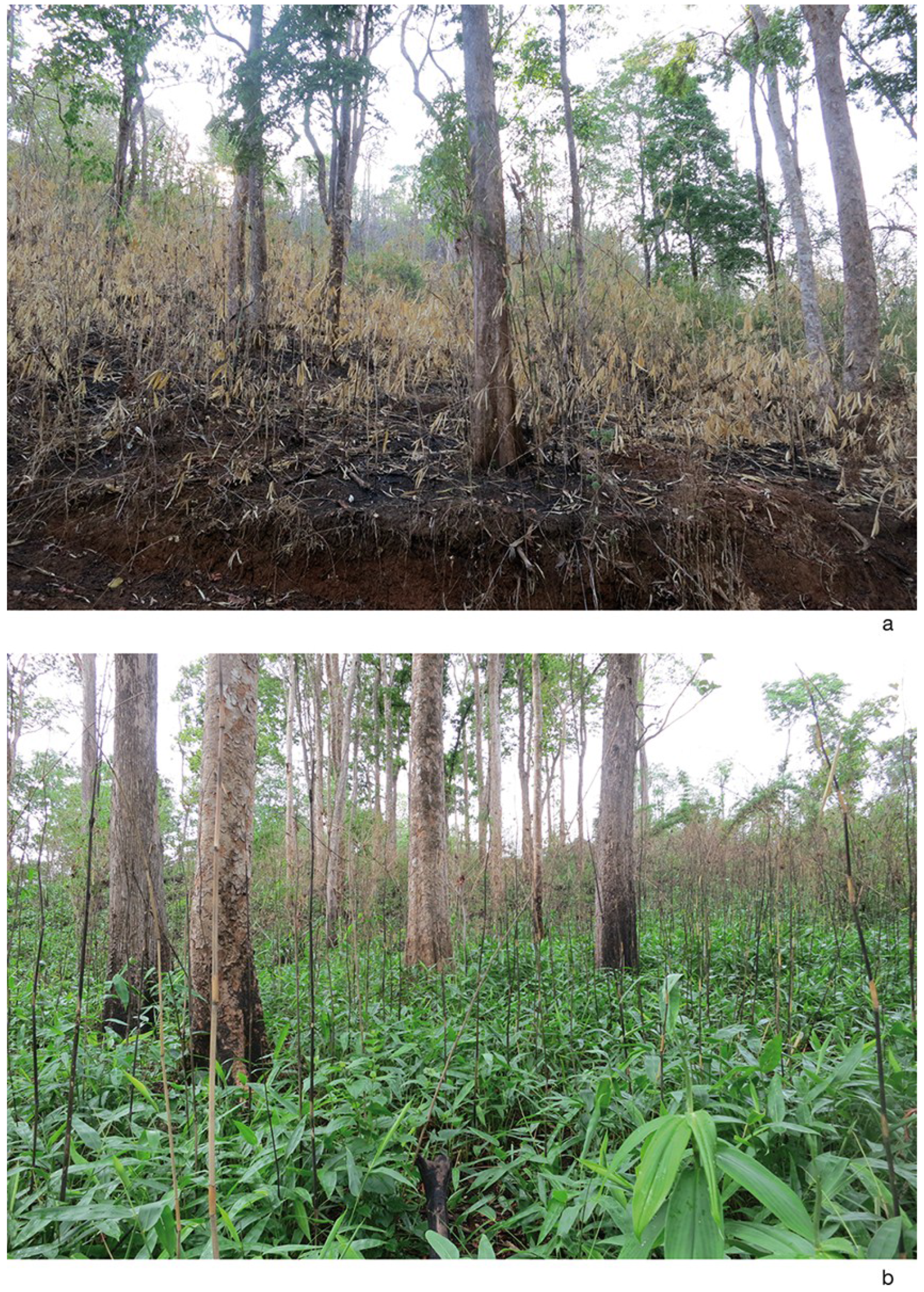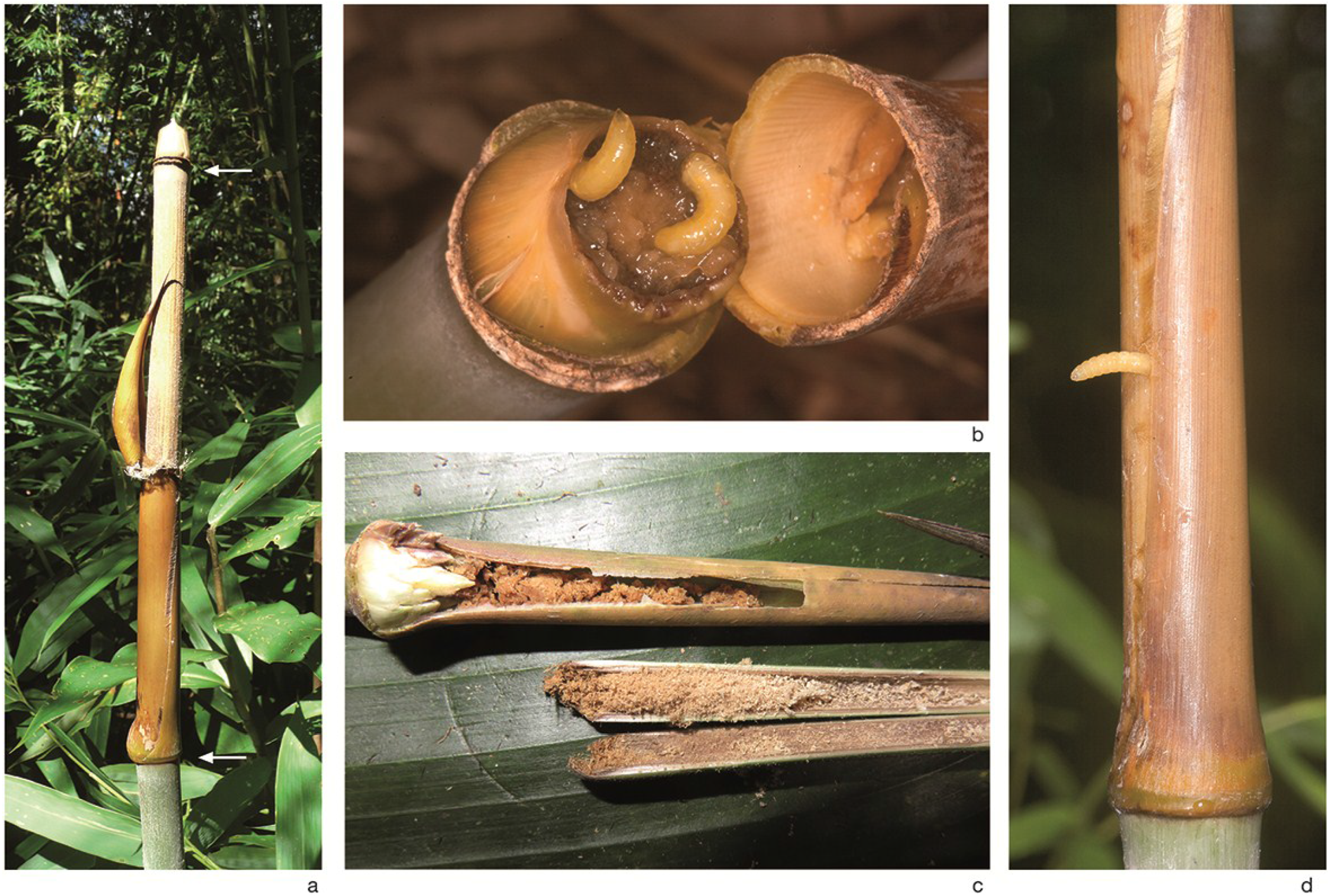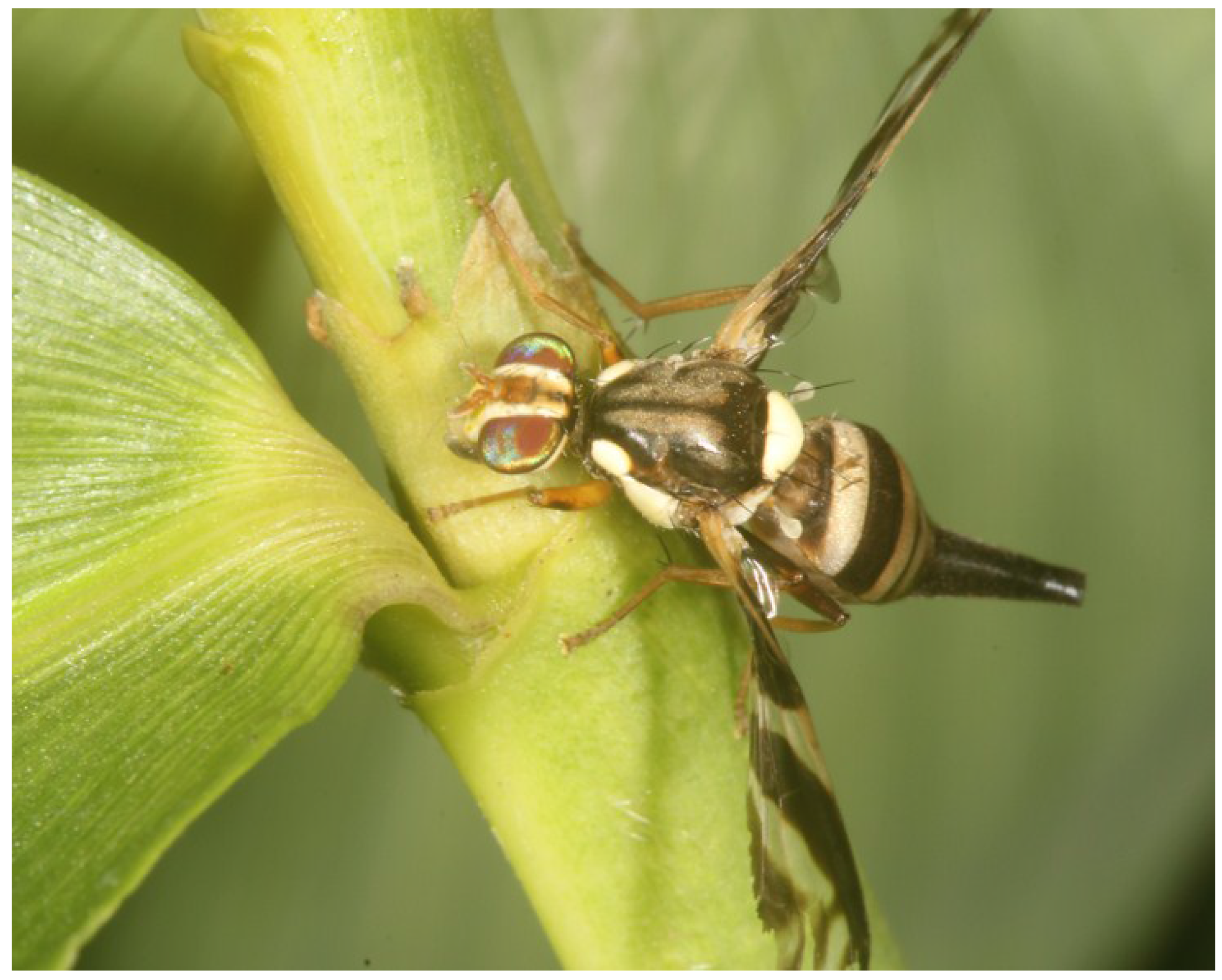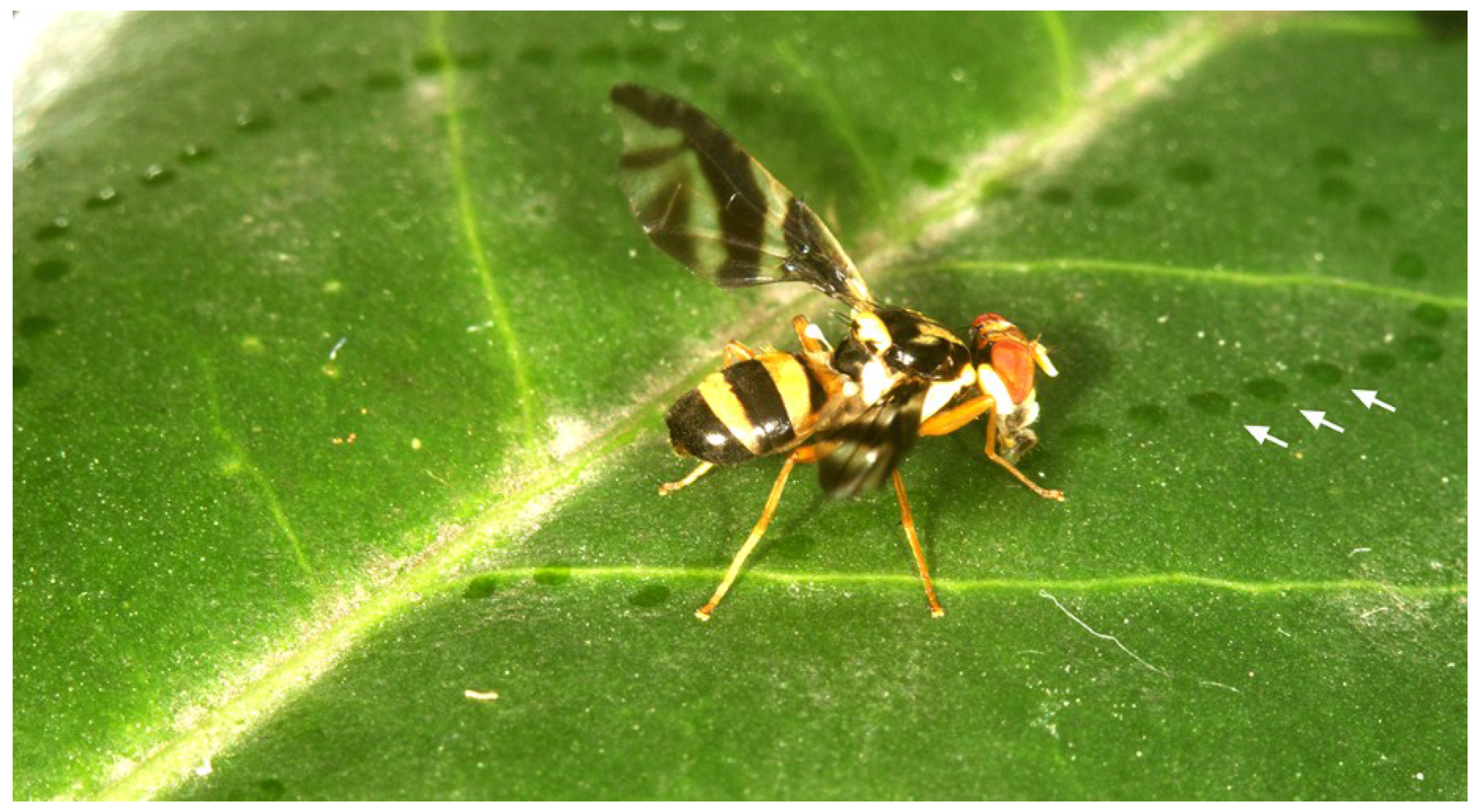Reproductive Behavior and Basic Biology of the Oriental Bamboo-Inhabiting Anoplomus rufipes and a Comparison with Frugivorous Dacinae Fruit Flies
Abstract
:1. Introduction
2. Experimental Section
2.1. Location of the Study Area and Climate
2.2. Sampling Methods
2.3. Field Observations

2.4. Rearing
2.5. Behavioral Observations in the Laboratory
3. Results
3.1. Habitat and Temporal Occurrence of the Adults
3.2. Host Plant and Larval Development


3.3. General Behavior of the Adults
3.3.1. Locomotion and Wing Displays
| Behavioral Patterns | Behavioral Context | Laboratory | Field |
|---|---|---|---|
| Walking, flying | Locomotion | x | x |
| Turning towards moving objects | Orientation | x | x |
| Enantion (wing display) | Function? | x | x * |
| Supination (wing display) | Function? | x | x * |
| Lunging forwards | Agonistic behavior | x | x |
| Pounding with forelegs | Agonistic behavior | x | x |
| Lofting (wing display) | Agonistic behavior | x | - |
| Lofting/ body swaying | Agonistic behavior | x | - |
| Wing vibration | Agonistic behavior | x | - |
| Grooming movements | Cleaning behavior | x | x |
| Dabbing with proboscis | Feeding, excretion behavior | x | x |
| Oral droplet deposition | Feeding, excretion behavior | x | - |
| Oral droplet extrusion | Feeding, excretion behavior | x | x |
| Feces disposal (+ abdominal dragging) | Feeding, excretion behavior | x | x |
| Abdominal elevation (calling) | Courtship behavior | - | x |
| Anal pouch eversion (calling) | Courtship behavior | - | x |
| Abdominal pleural distention (calling) | Courtship behavior | - | x |
| Lofting/body swaying | Courtship behavior | - | x |
| Looping flights | Courtship behavior | - | x |
| Anal dabbing | Courtship (marking) behavior | - | x |
3.3.2. Grooming
3.3.3. Feeding and Feces Elimination

3.3.4. Oral Droplet Deposition and Oral Droplet Extrusion (Bubbling)


3.3.5. Agonistic Behavior in Males and Females

3.4. Reproductive Behavior
3.4.1. Mating Site and Temporal Occurrence of the Courtship Behavior
3.4.2. Aggregation Phase
Searching for Mates and Pheromone Calling

Agonistic Behaviors during Courtship
Lek Formation
3.4.3. Courtship Phase
3.4.4. Copulatory Phase

4. Discussion
4.1. General Biology and Behavior
4.1.1. Host Plant Phenology, Larval Development and Life Cycle
4.1.2. Food
4.1.3. General Behavior
4.2. Reproductive Behavior
4.2.1. Reproductive Behaviors in Dacinae
Aggregation Phase
| Behavioral Phases | Male Behavior | C. capitata | A. rufipes | Bactrocera |
|---|---|---|---|---|
| Aggregation phase (long range) | Abdominal elevation | x | x | - |
| Anal pouch eversion (P) | x | x | - | |
| Abd. pleural distention (P) | x | x | - | |
| Anal dabbing (P) | x | x | - | |
| Anus beating/fanning (P/S) | - | - | x/- | |
| Wing displays (V) | - | x | - | |
| Looping flights (V) | - | x | - | |
| Lek formation | x | x | x/- | |
| Courtship phase (short range) | Abdominal elevation | x | x | - |
| Anal pouch eversion (P) | x | x | - | |
| Abd. pleural distention (P) | x | x | - | |
| Anus beating/fanning (P/S)) | - | - | x/- | |
| Continuous wing vibr. (P/S) | x | - | - | |
| Other types of stridulation (S) | x | - | x/- | |
| Head rocking (V) | x | - | - | |
| Wing display (V) | - | x | - | |
| Lofting/Body swaying (V) | - | x | - | |
| Arista tapping (T) | x | - | - | |
| Copulatory phase (contact range) | Wing buzzing (S/T) | x | - | x |
| Body rocking (T) | x | - | x | |
| Surstyli nipping (T) | x | - | - | |
| Aculeus raising (T) | x | - | - | |
| Hind tarsi rubbing (T) | x | - | x |
Courtship Phase
Copulatory Phase
4.2.2. Comparison of the Reproductive Behaviors of Anoplomus, Ceratitis and Bactrocera
4.2.3. Choice of the Mating Site
4.2.4. Lek Formation
4.2.5. Mating System in Gastrozonini
5. Conclusions
Acknowledgments
Conflicts of Interest
References
- Burk, T. Signaling and sex in acalyptrate flies. Fla. Entomol. 1981, 64, 30–43. [Google Scholar] [CrossRef]
- Sivinski, J.; Aluja, M.; Dodson, G.; Freidberg, A.; Headrick, D.; Kaneshiro, K.; Landolt, P. Topics in the Evolution of Sexual Behavior in the Tephritidae. In Fruit Flies (Tephritidae): Phylogeny and Evolution of Behavior; Aluja, M., Norrbom, A.L., Eds.; CRC Press: Boca Raton, FL, USA, 2000; pp. 751–792. [Google Scholar]
- Dodson, G.N. Behavior of the Phytalmiinae and the evolution of antlers in tephritid flies. In Fruit Flies (Tephritidae): Phylogeny and Evolution of Behavior; Aluja, M., Norrbom, A.L., Eds.; CRC Press: Boca Raton, FL, USA, 2000; pp. 175–184. [Google Scholar]
- Dohm, P.; Kovac, D.; Freidberg, A.; Hashim, R.B. Biology of the Oriental bamboo-inhabiting fly Felderimyia gombakensis and observations on mating trophallaxis in Felderimyia (Insecta, Diptera, Tephritidae, Phytalmiinae, Acanthonevrini). Senck. Biol. 2008, 88, 311–318. [Google Scholar]
- Kovac, D.; Dohm, P.; Freidberg, A. Field observations on the mating behaviour of the Oriental Rioxa sexmaculata (van der Wulp) (Diptera: Tephriidae) and a review of the reproductive behaviour patterns in Acanthonevrini. Biosystematica 2010, 4, 5–14. [Google Scholar]
- White, I.M.; Elson-Harris, M.M. Fruit Flies of Economic Significance: Their Identification and Bionomics; CAB International: Wallingford, UK, 1994; pp. 1–601. [Google Scholar]
- Hancock, D.L.; Drew, R.A.I. Bamboo-shoot fruit flies of Asia (Diptera: Tephritidae: Ceratitidinae). J. Nat. Hist. 1999, 33, 633–775. [Google Scholar] [CrossRef]
- Copeland, R.S. On the occurrence of Bistrispinaria, grass-breeding fruit flies (Diptera, Tephritidae), in Kenya, with an addition to the tephritid checklist of Kakamega forest. J. East Afr. Nat. Hist. 2007, 96, 95–102. [Google Scholar] [CrossRef]
- Kovac, D.; Dohm, P.; Freidberg, A.; Norrbom, A.L. Catalog and Revised Classification of the Gastrozonini (Diptera: Tephritidae. Dacinae). Available online: http://www.entomology.org.il/sites/default/files/pdfs/p.163%20kovac%20et%20al.pdf (accessed on 2 June 2015).
- Dohm, P.; Kovac, D.; Freidberg, A.; Rull, J.; Aluja, M. Basic biology and host use patterns of tephritid flies (Phytalmiinae: Acanthonevrini, Dacinae: Gastrozonini) breeding in bamboo (Poacea: Bambusoidea). Ann. Entomol. Soc. Am. 2014, 107, 184–203. [Google Scholar] [CrossRef]
- Headrick, D.; Goeden, R.D. Reproductive behavior of California fruit flies and the classification and evolution of Tephritidae (Diptera) mating systems. Stud. Dipterol. 1994, 1, 195–252. [Google Scholar]
- Kovac, D.; Freidberg, A.; Steck, G. Biology and description of the third instar larva and puparium of Ichneumonopsis burmensis Hardy (Diptera, Tephritidae, Dacinae, Gastrozonini), a bamboo-breeding fruit fly from the Oriental region. Raffles. Bull. Zool. 2013, 61, 117–132. [Google Scholar]
- Sivinski, J.M.; Epsky, N.; Heath, R.R. Pheromone deposition on leaf territories by male Caribbean fruit flies, Anastrepha suspensa (Loew) (Diptera: Tephritidae). J. Insect Behavior. 1994, 7, 43–51. [Google Scholar] [CrossRef]
- Aluja, M.; Piñero, J.; Jácome, I.; Díaz-Fleischer, F.; Sivinski, J. Behavior of flies in the genus Anastrepha (Trypetinae: Toxotrypanini). In Fruit Flies (Tephritidae): Phylogeny and Evolution of Behavior; Aluja, M., Norrbom, A.L., Eds.; CRC Press: Boca Raton, FL, USA, 2000; pp. 375–408. [Google Scholar]
- Vijaysegaran, S.; Walter, S.H.; Drew, R.A.I. Mouthpart structure, feeding mechanisms, and natural food sources of adult Bactrocera (Diptera: Tephritidae). Ann. Entomol. Soc. Am. 1997, 90, 184–201. [Google Scholar] [CrossRef]
- Drew, R.A.I.; Yuval, B. The evolution of fruit fly feeding behaviour. In Fruit Flies (Tephritidae): Phylogeny and Evolution of Behavior; Aluja, M., Norrbom, A.L., Eds.; CRC Press: Boca Raton, FL, USA, 2000; pp. 457–487. [Google Scholar]
- Nishida, T. Extrafloral glandular secretions, a food source for certain insects. Proc. Hawaii Entomol. Soc. 1958, 16, 379–386. [Google Scholar]
- Hendrichs, J.; Hendrichs, M. Mediterranean fruit fly (Diptera: Tephritidae) in nature: Location and diel pattern of feeding and other activities on fruiting and non-fruiting hosts and nonhosts. Ann. Entomol. Soc. Am. 1990, 83, 632–641. [Google Scholar] [CrossRef]
- Hendrichs, J.; Katsoyannos, B.I.; Papay, D.R.; Prokopy, R.J. Sex differences in movement between natural feeding and mating sites and tradeoffs between food consumption, mating success and predator evasion in Mediterranean fruit flies (Diptera: Tephritidae). Oecologia 1991, 86, 223–231. [Google Scholar] [CrossRef]
- Ben-Yosef, M.; Pasternak, Z.; Jukevitch, E.; Yuval, B. Symbiotic bacteria enable olive flies (Bactrocera oleae) to exploit intractable sources of nitrogen. J. Evol. Biol. 2014, 27, 2695–2705. [Google Scholar] [CrossRef] [PubMed]
- Nicolson, S.W.; Thornburg, R.W. Nectar chemistry, Chapter 5. In Nectaries and Nectar; Nicolson, S.W., Nepi, M., Pacini, E., Eds.; Springer: Dordrecht, The Netherlands, 2007; pp. 215–264. [Google Scholar]
- Mather, M.H.; Roitberg, B.D. A sheep in wolf’s clothing: tephritid flies mimic spider predators. Science 1987, 224, 302–303. [Google Scholar] [CrossRef] [PubMed]
- Greene, E.; Orsack, E.J.; Whitman, D.W. A tephritid fly mimics the territorial displays of its jumping spider predators. Science 1987, 236, 310–312. [Google Scholar] [CrossRef] [PubMed]
- Hendrichs, J.; Cooley, S.S.; Prokopy, R.J. Post-feeding bubbling behaviour in fluid-feeding Diptera: concentration of crop contents by oral evaporation of excess water. Physiol. Entomol. 1992, 17, 153–161. [Google Scholar] [CrossRef]
- Hendrichs, J.; Fletcher, B.S.; Prokopy, R.J. Feeding behavior of Rhagoletis pomonella flies (Diptera: Tephritidae): Effect of initial food quantity and quality on food foraging, handling costs and bubbling. J. Insect Behavior. 1993, 6, 43–64. [Google Scholar] [CrossRef]
- Drew, R.A.I.; LLoyd, A.C. Relationship of fruit flies (Diptera: Tephritidae) and their bacteria to host plants. Ann. Entomol. Soc. Am. 1987, 80, 629–636. [Google Scholar] [CrossRef]
- Kovac, D.; Senckenberg Research Institute, Frankfurt, Germany. Personal Communication, 2015.
- Eberhard, W.G. Sexual behaviour and sexual selection in the Mediterranean fruit fly, Ceratitis capitata (Dacinae, Ceratitidini). In Fruit Flies (Tephritidae): Phylogeny and Evolution of Behavior; Aluja, M., Norrbom, A.L., Eds.; CRC Press: Boca Raton, FL, USA, 2000; pp. 457–487. [Google Scholar]
- Fletcher, B.S. Storage and release of a sex pheromone by the Queensland fruit fly, Dacus tryoni (Diptera: Trypetidae). Nature 1968, 219, 631–632. [Google Scholar] [CrossRef] [PubMed]
- Fletcher, B.S. The structure and function of the sex pheromone glands of the male Queensland fruit fly, Dacus tryoni. J. Insect. Physiol. 1969, 15, 1309–1322. [Google Scholar]
- Nation, J.L. Sex-specific glands in tephritid fruit flies of the genera Anastrepha, Ceratitis, Dacus and Rhagoletis (Diptera: Tephritidae). Int. J. Insect Morphol. Embryol. 1981, 10, 121–129. [Google Scholar] [CrossRef]
- Nation, J.L. 3.4.5. Role of pheromones in the mating system of Anastrepha fruit flies. In World Crop Pests 3A. Fruit Flies Their Biology, Natural Enemies and Control; Robinson, A.S., Hooper, G., Eds.; Elsevier: Amsterdam, The Netherlands, 1989; pp. 189–204. [Google Scholar]
- Koyama, J. Tropical Dacinae. In World Crop Pests 3A. Fruit Flies Their Biology, Natural Enemies and Control; Robinson, A.S., Hooper, G., Eds.; Elsevier: Amsterdam, The Netherlands, 1989; pp. 165–169. [Google Scholar]
- Jones, O. Ceratitis capitata. In World Crop Pests 3A. Fruit Flies Their Biology, Natural Enemies and Control; Robinson, A.S., Hooper, G., Eds.; Elsevier: Amsterdam, The Netherlands, 1989; pp. 179–183. [Google Scholar]
- Kuba, H.; Sokei, Y. The production of pheromone clouds by spraying in the melon fly, Dacus curcubitae Coquillet (Diptera: Tephritidae). J. Ethol. 1988, 6, 105–110. [Google Scholar] [CrossRef]
- Monro, J. Stridulation in the Queensland fruit fly Dacus (Strumenta) tryoni (Frogg.). Aust. J. Sci. 1953, 16, 60–62. [Google Scholar]
- Tychsen, P.H. Mating behaviour of the Qeensland fruit fly, Dacus tryoni (Diptera: Tephritidae) in field cages. J. Aust. Entomol. Soc. 1977, 16, 459–465. [Google Scholar] [CrossRef]
- Fletcher, B.S.; Giannakakis, A. Factors limiting the response of females of the Queensland fruit fly, Dacus tryoni, to the sex pheromone of the male. J. Insect Physiol. 1973, 19, 1147–1155. [Google Scholar]
- Kuba, H.; Koyama, J. Mating behaviour of wild Melon Flies, Dacus curcubitae Coquillet (Diptera: Tephritidae) in a field cage: Courtship behaviour. Appl. Ent. Zool. 1985, 20, 365–372. [Google Scholar]
- Ohinata, K.; Jacobson, M.; Kobayashi, R.M.; Chambers, D.L.; Fujimoto, M.S.; Higa, H.H. Oriental fruit fly and melon fly: Biological and chemical studies of smoke produced by males. J. Environ. Sci. Health 1982, 17, 197–206. [Google Scholar]
- Pike, N.; Meats, A. Tendency for upwind movement in the sibling fruit fly species Bactrocera tryoni and B. neohumeralis and their hybrids (Diptera: Tephritidae): Influence of time of day, sex and airborne pheromone. Bull. Entomol. Res. 2003, 93, 173–178. [Google Scholar] [CrossRef] [PubMed]
- Wee, S.-L.; Tan, K.-H. Female sexual response to male rectal volatile constituents in the fruit fly Bactrocera carambolae (Diptera: Tephritidae). App. Entomol. Zool. 2005, 40, 365–372. [Google Scholar] [CrossRef]
- Drew, R.A.I.; Rodgers, D.J.; Vijaysegaran, J.; Moore, C.J. Mating activity of Bactrocera cacuminata (Hering) (Diptera: Tephritidae) on its larval host plant Solanum mauritianum Scopoli in southeast Queensland. Bull. Entomol. Res. 2008, 98, 77–81. [Google Scholar] [CrossRef] [PubMed]
- Benelli, G.; Daane, K.M.; Canale, A.; Niu, C.-Y.; Messing, R.H.; Vargas, R.I. Review: Sexual communication and related behaviours in Tephritidae: Current knowledge and potential applications for Integrated Pest Management. J. Pest Sci. 2014, 87, 385–405. [Google Scholar] [CrossRef]
- Arita, L.H.; Kaneshiro, K.Y. Sexual selection and lek behavior in the Mediterranean fruit fly, Ceratitis capitata (Diptera: Tephritidae). Pac. Sci. 1989, 43, 135–143. [Google Scholar]
- Rolli, K. Die akustischen Sexualsignale von Ceratitis capitata Wied. und Dacus oleae Gmel. Z. Ang. Ent. 1976, 81, 219–223. (In German) [Google Scholar] [CrossRef]
- Briceño, R.D.; Eberhard, W.G. Courtship in the medfly, Ceratitis capitata, includes tactile stimulation with the male’s aristae. Entomol. Exp. Appl. 2002, 102, 221–228. [Google Scholar] [CrossRef]
- Briceño, R.D.; Ramos, D.; Eberhard, W.G. Courtship behavior of male Ceratitis capitata (Diptera: Tephritidae) in captivity. Fla. Entomol. 1996, 79, 130–143. [Google Scholar] [CrossRef]
- Poramarcom, R. Sexual Communication in the Oriental Fruit Fly, Dacus dorsalis Hendel (Diptera: Tephritidae). Ph.D. Thesis, University of Hawaii, Honolulu, HI, USA, 1988. [Google Scholar]
- Iwahashi, O.; Majima, T. Lek formation and male-male competition in the Melon Fly, Dacus curcubitae Coquillet (Diptera: Tephritidae). Appl. Ent. Zool. 1986, 21, 70–75. [Google Scholar]
- Aluja, M. Unusual calling behavior of Anastrepha robusta flies (Diptera: Tephritidae) in nature. Fla. Entomol. 1993, 76, 391–395. [Google Scholar] [CrossRef]
- Féron, M. Línstinct de reproduction chez la mouche méditerranéene des fruits Ceratitis capitata. Comportement sexuel. Comportement de ponte. Rev. Pathol. Vég. Agric. Fr. 1962, 41, 1–129. (In French) [Google Scholar]
- Kaspi, R.; Yuval, B. Mediterranean fruit fly leks: Factors affecting male location. Funct. Ecol. 1999, 13, 539–545. [Google Scholar] [CrossRef]
- Shelly, T.E. Scent marking by males of the Mediterranean fruit fly, Ceratitis capitata (Diptera: Tephritidae). J. Insect Behavior. 2004, 17, 709–722. [Google Scholar] [CrossRef]
- Perdomo, A.J.; Nation, J.L.; Baranowski, R.M. Attraction of male and female Caribbean fruit flies to food-baited and male-baited traps under field conditions. Environ. Ent. 1976, 5, 1208–1210. [Google Scholar] [CrossRef]
- Droney, D.C. Test of hypotheses for lek formation in a Hawaiian Drosophila. Anim. Behav. 1994, 47, 351–361. [Google Scholar] [CrossRef]
- Whittier, T.S.; Kaneshiro, K.Y.; Prescott, L.D. Mating behavior of Mediterranean fruit flies (Diptera: Tephritidae) in a natural environment. Ann. Entomol. Soc. 1992, 85, 214–218. [Google Scholar] [CrossRef]
- Benelli, G. Aggressive behavior and territoriality in the olive fruit fly, Bactrocera oleae (Rossi) (Diptera: Tephritidae): Role of residence and time of day. J. Insect. Behav. 2014, 27, 145–161. [Google Scholar] [CrossRef]
- Kuba, H.; Koyama, J.; Prokopy, R.J. Mating behaviour of wild melon flies, Dacus curcubitae Coquillet (Diptera: Tephritidae) in a field cage: distribution and behaviour of flies. Appl. Ent. Zool. 1984, 19, 367–373. [Google Scholar]
- Emlen, S.T.; Oring, L.W. Ecology, sexual selection, and the evolution of mating systems. Science 1977, 197, 215–223. [Google Scholar] [CrossRef] [PubMed]
- Prokopy, R.J. Mating behaviour of frugivorous Tephritidae in nature. In Proceedings of the Symposium of Fruit Fly Problems; Koyama, J., Ed.; XVI Int. Congr.Entomol.: Kyoto, Japan, 1980; pp. 37–46. [Google Scholar]
- Fletcher, B.S. The biology of Dacinae fruit flies. Ann. Rev. Entomol. 1987, 32, 115–144. [Google Scholar] [CrossRef]
© 2015 by the authors; licensee MDPI, Basel, Switzerland. This article is an open access article distributed under the terms and conditions of the Creative Commons Attribution license (http://creativecommons.org/licenses/by/4.0/).
Share and Cite
Kovac, D. Reproductive Behavior and Basic Biology of the Oriental Bamboo-Inhabiting Anoplomus rufipes and a Comparison with Frugivorous Dacinae Fruit Flies. Insects 2015, 6, 869-896. https://doi.org/10.3390/insects6040869
Kovac D. Reproductive Behavior and Basic Biology of the Oriental Bamboo-Inhabiting Anoplomus rufipes and a Comparison with Frugivorous Dacinae Fruit Flies. Insects. 2015; 6(4):869-896. https://doi.org/10.3390/insects6040869
Chicago/Turabian StyleKovac, Damir. 2015. "Reproductive Behavior and Basic Biology of the Oriental Bamboo-Inhabiting Anoplomus rufipes and a Comparison with Frugivorous Dacinae Fruit Flies" Insects 6, no. 4: 869-896. https://doi.org/10.3390/insects6040869






